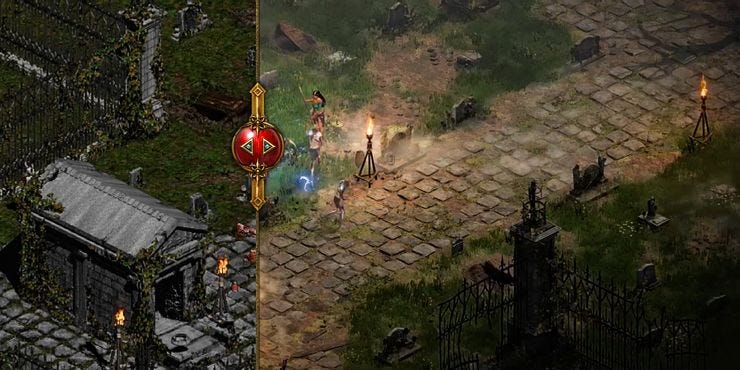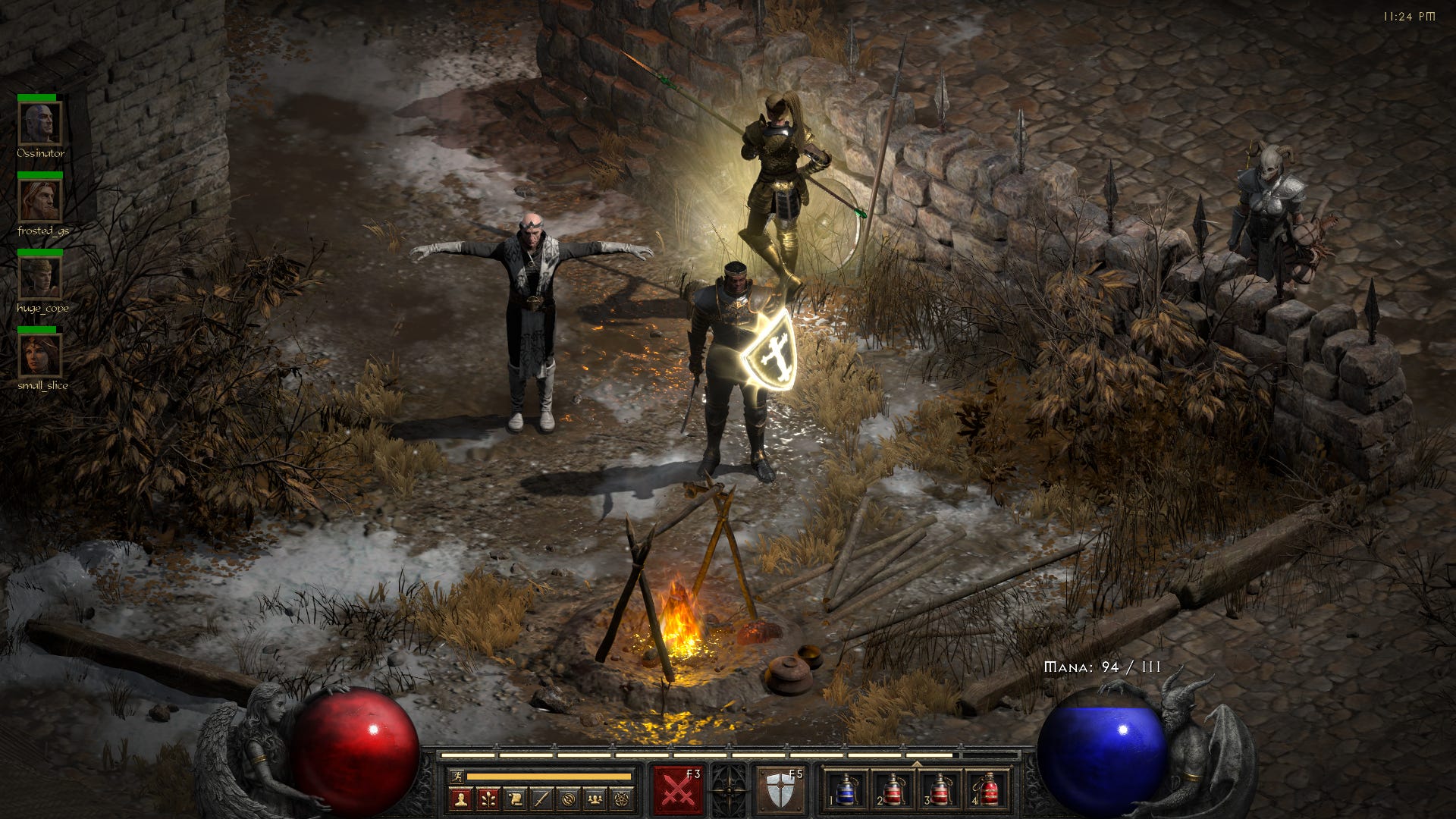Sharp Edges: Diablo 2 and Nostalgia
“Why keep time traveling if it doesn’t get better on the second time around?”
— Eleanor Friedberger
I’ve been playing Diablo 2: Resurrected, the remaster of the RPG Diablo 2, these past few months. This is a game from Blizzard, so it feels worthwhile to mention upfront the recent allegations of their management's abuse and misconduct. I must sidestep these conversations, as people far more qualified than I continue to share their perspectives on this evolving topic. I don’t particularly like Blizzard as a company; I don’t particularly like any company. But I’m intellectually compelled to critique D2:R and document how surreal it feels to play.
The original Diablo 2 was very important to me. I remember: watching my uncle duplicate items in the original title; multiplayer afternoons with brothers and cousins; performing hypnotic loot runs in my friend’s computer room in high school. I probably sunk a few hundred hours into this game before I hit 16, but I haven’t touched the game in more than a decade. Thus, anything I write about the remaster will surely be suffused with a nostalgic’s fervor.
Of course, that’s the whole point of the remaster, the whole reason it exists: people harbor a deep nostalgia for the original experience. Its true sequel Diablo 3 was a commercial success, but to this day sustains a font of scoffs and dismissals from the realest Diablo fans (I watched a D2 streamer visually cringe while hedging: ‘D3 is an okayish game’). D2 is the entry in the series that lingers in people’s minds. Many people, in a constellation of active online communities, were still regularly playing the 20-year-old game as its remaster was announced and rolled out.
We can understand ‘nostalgia’ etymologically as “home pain,” as the more abstract, poetic cousin of homesickness. The core that sustains nostalgia, that provides its trademark ache, is loss: the object of our nostalgia is forever lost, never to return, faded away with a bygone era. Any attempt to return to it is to universally be met with disappointment. It’s no longer the same, we think, or it is the same but it is us who have changed. The core of nostalgia is therefore a void, a ghostly fragment of an emotional memory, something that maybe never existed as we remembered it in the first place.
But does it have to be that way?

Remasters and remakes are the renderings of an impossible temporal desire. We want them to, in essence, send us back in time. We also want them to bring our rose-tinted past to its future, our present. Three temporalities braided into one art object. Diablo 2: Resurrected wants so badly to thread that needle: to provide the old experience we cherish while simultaneously bringing us someplace new.
Repeatedly in the run-up to the release, the devs stressed the fidelity of the new experience to the old. Indeed, their alterations to the original are amazingly sparse; the best list I could find tops out at about 29 items, most as granular as “cow king kill causing lock-out removed” and “added in-game clock” (which is like “adding a skylight to a casino,” said my friend Steve). The remaster contains a whole visual and audio update, of course, but the devs seem laser-focused on recreating the feel of the original. After the beta, for example, they made several negligible tweaks in response to player feedback: the Sorceress’s lightning didn’t “feel” right until it was brightened a bit; the town portal “felt off” until its blue ring was properly thickened. One gets the sense that the team approached the project with great care and precision, trying to look at their remaster through the eyes of the devoted-yet-jaded D2 player who bounced off the rounded edges of D3.
But the technical backbone that makes D2:R a feat of engineering is—and the devs specifically framed it this way—the original, 2D, isometric Diablo 2 game itself is actually running “under” the 3D remaster. The entire original game is there, you’re playing it, and the remaster is, I imagine, interpreting the original’s code into new visuals. It’s like they dug up the old game’s skeleton and hung new flesh off its low-resolution bones, puppeteering their chimera to perform the stories we remember from decades past.
That analogy implies some deceit (grave robbery, ghoulish pantomime) but the devs aren’t trying to hide anything. In fact, the most interesting feature of D2:R is the “legacy” button: you push the G key and, like dark magic, the flashy new graphics and sharpened UI and remastered music dissolve away, and there’s reliable, chunky old Diablo 2, just how you kind of remember it. You can push this button at anytime during play and the game doesn’t miss a beat. It’s like the devs are daring you to check their work.

Frankly, the legacy button blows my mind, specifically in how it toys with my perception of time and memories. Players can mash the button repeatedly, flickering back and forth between a charmingly crude simulation of reality (old), and a hyperreal, gently modern simulation of that older simulation of reality (old made new). You can compare sprites, sounds, and cinematic moments on the fly. Pushing the legacy button feels like a velvet curtain being lifted, revealing hidden truth—ah! but it’s been the old game the whole time.
One of the odd sensations legacy mode provides is that the original game is not quite how we remembered it: “I could have sworn it looked a lot better” is the refrain. A cursory glance online finds droves of people saying that the legacy mode is somehow inaccurate to their memory. Even this comedic Honest Trailer of the game mentions this sense of mismatch. We’re all wrong, of course, as the legacy mode is the same exact program we played as kids. The confused response is a natural product of the fallibility of memory, the nostalgia trap.
But somehow, to me, the spruced-up remaster feels more akin to my actual experience of the game, the actual texture of moods and sensations, than legacy mode. About the updated graphics one friend quipped, “I bet this is how it looked to us 20 years ago.” It’s like the old graphics were only compatible with our older eyes, and in order to replicate the experience for our new eyes, in order to match the tenor of that experience, the experience itself needed a compatibility update.
This sensation, coupled with the spatial metaphor supplied by the devs (that the original game is running “under” the remaster), brings to mind Borges’s idea of the “map of the Empire whose size was that of the Empire.” It’s the simulation that overtakes the object it’s simulating, what Baudrillard called “the map that precedes the territory.” The simulation of the thing becomes so convincing, so seductive, so nuanced and real, that it starts to rewrite the reality of the original and our relationship to it. It overtakes as the new reality, the hyperreal, and the old reality feels charmingly remote, alien.
There’s a disjointedness of time and game-design technique that the legacy button also accentuates: even with the remastered visuals, the game’s ludic elements are distinctly out of fashion. Diablo 2 is a famously difficult, borderline unforgiving game, and those sharp edges feel sharper today. Much of the remaster’s post-launch reviews have boiled down to: “It’s Diablo 2 just how you remember it, but that’s not necessarily a good thing.” These reviewers rightfully cite the frictive elements that would bother the contemporary gamer, things that were sanded down in later action RPGs: stamina, potion management, the risk of irreversibly fucking up your character early on. To these reviewers, D2:R is haunted by baffling design decisions of the past, which are representative of an older, less-refined style of game-making. In retort, the dedicated D2 fan would argue that these sharp edges are “the point,” i.e., D2’s staying power is a product of it’s sometimes-unintuitive or needlessly frustrating elements.
The concept of the remaster or remake certainly pulls this kind of critique to the fore of the mind: does the game/song/movie, dressed up in its fancy modern clothes, hold up in the context of a modern media ecosystem? Does it feel like, if it were released today, it’d still be a critical darling, or a failure? But the legacy button invites us to invert these questions: do the fancy modern clothes hold up to your internal subjective experience of the original game? Is the sorceress’s new lightning bright enough yet? When does it feel right?
Videogames really are about feeling. Not necessarily emotional feeling, but, to quote Ashbery on his own poetry, “the experience of experience.” It feels like something to go grocery shopping, call your parents, ride a cab late at night, or wake up early for a road trip. In the same way, it feels like something to organize your potions. It feels like something to sit around in town mindlessly chatting and spamming emotes. The texture of these feelings is the result of many little bits, both diegetic and non-, singing in otherworldly harmony. It’s the alchemical process where something becomes more than the sum of its parts. It’s hard to predict what will click, and even harder to replicate it.

In some ways, D2:R presents a classic form vs. content question: which shapes which? Does the form guide the content, or does the content guide the form? Is it more of a synthesis, each driving the other in a sort of fluid, unpredictable relationship, like if liquid affected the shape of the glass it was poured into?
If we think of “form” as the underlying ludological base of the game—the internal principles that organize its discrete elements—and “content” as the aesthetic and narratological substance, the nexus where mechanics are transmogrified into meaning, the plane of interaction with the player’s mind and heart, then the legacy button brings that border into legibility. We can learn more about this action RPG form that has mesmerized millions by pouring the different liquids into it and watching the shape change. At the same time, we’re watching the way we feel about our memories change, revealing in itself a similar kind of internal form vs. unstable content conundrum.
The warped-nostalgia that I’m talking about promises to become more commonplace as big developers endlessly remaster and update their past glories. The most interesting other example also comes from Blizzard in World of Warcraft Classic, a re-release of the bloated MMO which rolled the game back to its starting point and is now getting expansions, forging an alternate timeline that’s the same game and same trajectory again but 15 years behind. Maybe every 15 years they’ll just start WoW over again and let aging nostalgia addicts live in a 2004–19 twilight for eternity. Sounds a bit like a circle of hell to me. What D2:R and other remasters try to do is fill that lossy void at the core of your nostalgia. They try to collapse the yawning distance to the past. You can go back, and even better, you can go back and not be disappointed. It’s better than you remember it. The framerate is higher.
Have you ever gone back to your kindergarten classroom? Everything is so comically tiny—the chairs you used to sit in, the playsets you remember climbing. Imagine going back but everything in the classroom was now adult-sized, enlarged in proportion to your enlarged body. That’s a feeling that someone could disappear into, probably willingly. But it’s a false feeling, one that flatters your false notions, that caters too willingly to your natural resistance to change. I’m enjoying D2:R. Its brilliant core loop is, to use a choice word, timeless. But it presents feelings that I’ve felt before, and more deeply then.